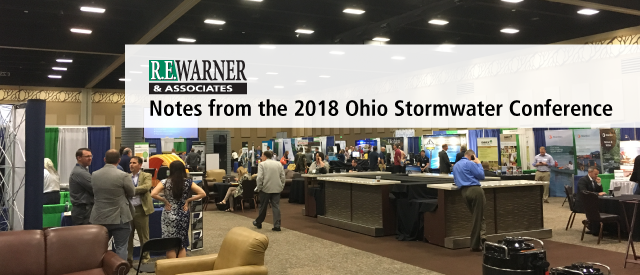
As regulations, technology, and engineering practices evolve, it is important for civil engineers, city officials, and those in the construction community to keep up to date with changes in the world of stormwater management.
Here in Ohio, we’re lucky that the Ohio Stormwater Association coordinates the annual Ohio Stormwater Conference, providing a one-stop shop for networking with and learning from those who are stormwater management experts and those who are responsible for the regulations governing the design of stormwater systems. I was fortunate to be one of the over 900 attendees at the 2018 conference held in May at the Kalahari Resort and Conference Center in Sandusky, Ohio. The event served as a great resource to get updates on environmental issues, new technologies, regulatory information and pollution prevention as it relates to stormwater management. Following are a few key takeaways from the conference:
A major topic at the conference was the Ohio EPA’s General Construction Permit update. This document specifies guidelines engineers must follow when designing a site, providing quantities, equations, and descriptions for different engineering techniques. The major change to the permit is a new water quality volume calculation. In the equations, the constant for precipitation depth was changed from 0.75 inches to 0.9 inches. This change increases the total water quality volume.
The water quality volume is a quantity used to determine how much water must be treated on a site. This quantity can affect the size and footprint of Best Management Practices (BMPs) employed at the site. (BMPs are structural, vegetative or managerial practices used to treat, prevent or reduce water pollution, such as stormwater basins, underground retention systems, or bioretention cells.)
While the Water Quality Volume calculation increased, the general permit also set forth a list of drainage techniques that if used will allow owners to reduce the overall water quality volume. This allows civil engineers to use different drainage techniques such as grass swales and filter strips to treat water before it enters a BMP. Doing this can decrease the size of a pond or underground storage tank which allows for more space to be utilized on a site.
Another hot topic at the conference, especially for those of us professionals who work in and around Cuyahoga County, was the Northeast Ohio Regional Sewer District’s Stormwater Master Plan presentation. NEORSD’s Regional Stormwater Management Program “addresses problems related to stormwater runoff from hard surfaces. Runoff contributes to regional stream flooding, erosion, and water-quality issues, and the program improves our ability to further address stormwater problems that cross community boundaries.” The presentation covered NEORSD’s strategy for prioritizing stormwater projects within different watersheds in order to maximize their effectiveness. In addition to executing its own green infrastructure projects, NEORSD is also encouraging property owners to complete their own stormwater control measure projects by extending a tax credit for completion of such work.
NEORSD has levied a tax based on impervious surface area on a property to help fund its stormwater management program. Property owners receive a credit through activities that reduce or alleviate the District’s cost of providing a stormwater program. For a flat 25% reduction, an owner can implement rain gardens, on-site stormwater storage, vegetated filter strips, or pervious pavement. For up to a 75% rate reduction, an owner needs to construct a SCM that reduces peak flow as well as the total runoff volume. We have helped many clients implement these SCMs, maximizing credits and performing the required yearly inspections for them. In one project for a scrap yard, we were able to utilize detention basins constructed several years ago to receive the stormwater fee credits.
From a “national trends” perspective, as an engineer, it is always helpful to see what new technologies and practices are being used in different parts on the country to get ideas for how to improve local practices. Several speakers presented permeable pavers case studies, giving us the opportunity to see whether and how this technique could be a better solution for some of our clients. As permeable pavers become more widely used, it is insightful to learn how other projects have fared using these materials and strategies. While, in the design process it is ultimately up to the client to decide what is in their best interest, we have found that permeable pavers are often an option that while more expensive up front can reduce long-term maintenance costs.
Finally, one of the keynote speakers at was Joe Sullivan of the Nation Weather Service. Joe spoke about weather and climate on a regional and global scale, describing both mankind’s effect on climate, as well as our inability to change things on a global and drastic scale. He also poignantly reminded attendees of our duty as engineers and builders to be mindful of climate, and to build and design responsibly so that our environment is not compromised for future generations.
Having had some time now to digest all of the insights from this conference, I am excited to be applying this knowledge in my day-to-day work at R.E. Warner and I’m looking forwarding to continuing to provide improved solutions for clients as stormwater management further evolves.

This post was written by Bill Vasko, EIT. Bill holds a Bachelor of Science in Civil Engineering from the University of Akron. His experience includes site design, stormwater management, roadway inspection, and construction management for a variety of public and private clients. His work experience includes civil engineering for the CUY-Independence All-Purpose Trail, Cuyahoga Community College's Plaza redesign, a new Service Garage & Salt Dome for the Village of Bratenahl, The City of Cleveland's E. 85
th/Chester Sewer Improvements, and multiple confidential industrial new construction and renovation projects.